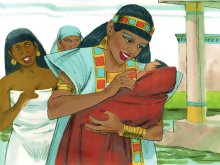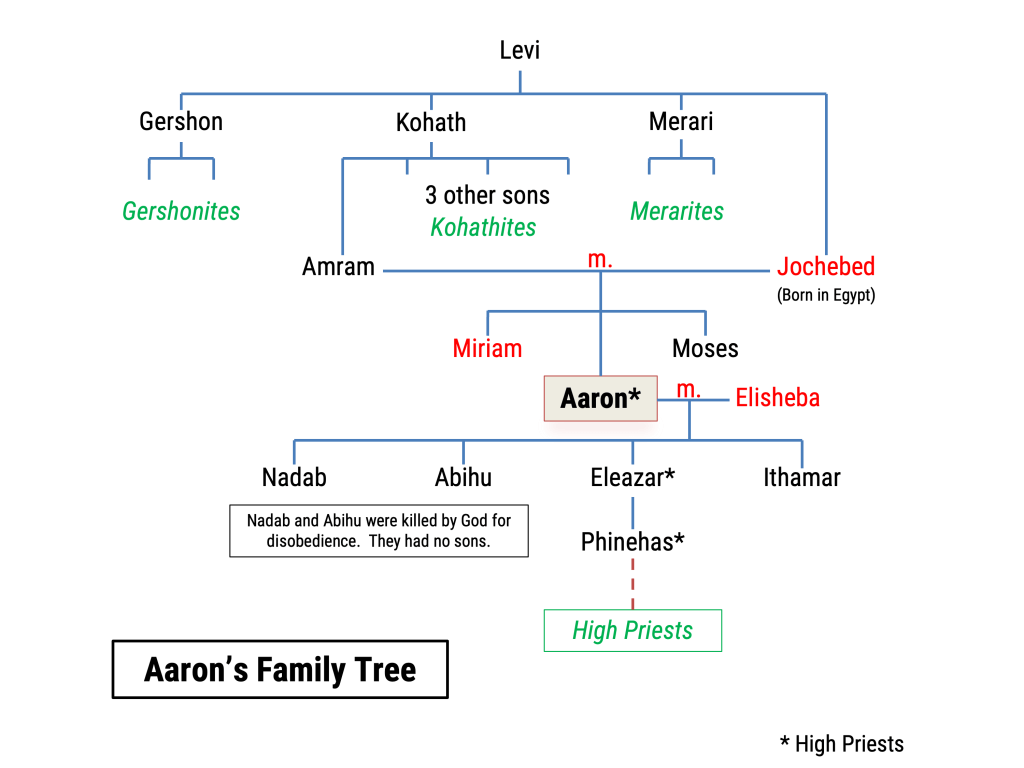Moses’ and Aaron’s family trees
By Mark Morgan | Family trees

Many people – perhaps most – have heard of the Ten Commandments or the Law of Moses. Fewer would know much about Aaron, Moses’ brother. In this article, we present Moses’ and Aaron’s family trees. Being brothers, the main difference is the central character – as you’ll see below.
We learn about the life of Moses in the Old Testament of the Bible, since he was born about 1,500 years before Jesus. However, the name of Moses was still known by everybody who lived in or around Israel in Jesus’ day, and the New Testament contains many references to the law which God gave through him.
So where did Moses come from and why was he so famous?
To understand Moses’ part in the history of Israel, we have to start with Abraham, who was told by God to leave Ur – an ancient city in modern-day Iraq – and go to a country that God would show him. Abraham obeyed and God led him to modern-day Israel, telling him after his arrival that he and his descendants would later own the land.
God also told him that there would be a 400-year delay before his descendants received the land, and this is just what happened. At the time of Abraham’s death, the only land he owned was a field he had bought as a burial place for his wife Sarah.
Some time later, his grandson Jacob took the entire family to Egypt to escape a famine, and they stayed there until the 400 years were completed. Initially the Egyptians welcomed Jacob’s family and showed them great kindness, but over time they reduced the Israelites to slavery and forced them to build store cities for their hosts. Not only so, but around the time Moses was born, Pharaoh the king decreed that any Hebrew baby boys were to be killed.
Despite Pharaoh’s cruel decree, Moses’ parents did their best to save his life, and for three months they hid him successfully. At that time, however, they felt compelled to take desperate measures to keep him alive. Making a small basket of bulrushes, waterproofed with bitumen and pitch, they put the basket in the river with baby Moses inside. They appear to have chosen the location carefully so that Pharaoh’s daughter would see the basket. Presumably they had some reason to believe that the princess would notice the basket and be unable to resist saving the baby boy inside. The plan worked. Pharaoh’s daughter saw the basket and sent her maids to fetch it. Although she quickly recognised the baby as a Hebrew boy, she was eager to keep him as her own. Moses’ older sister Miriam had been watching and now approached the princess, suggesting that she knew a Hebrew woman who could feed the baby for her. Incredibly, the princess agreed, so Moses was cared for by his own mother until he was weaned. At that time he went to live with Pharaoh’s daughter as her son, and she gave him the name ‘Moses’.
It seems very likely that Pharaoh’s daughter would have put two and two together and immediately understood the parentage of this cute little foundling. Despite this, she was willing to flout her father’s command and adopt a Hebrew boy.
We know nothing more about Moses’ childhood, but when he was about 40, he decided to renew his association with his own people, Israel. At that time he probably got to know his sister Miriam and his brother Aaron, and possibly others in the family. His time in Egypt came to an end at this point when he stood up for one of his countrymen and had to flee Pharaoh’s retribution.
He escaped to Midian and there married a wife Zipporah and they had two sons. When he was 80 years old and working as a shepherd, he saw a bush burning without being consumed. God spoke to him from this burning bush and told him to return to Egypt, meeting his brother Aaron on the way, and then lead the Israelites out of Egypt to the promised land.
Moses obeyed, but Pharaoh refused to let the Israelites go until forced to do so by ten terrible plagues, culminating in the death of all the firstborn sons of Egypt.
The people of Israel then left Egypt, crossed the Red Sea and went to Mount Sinai, where God gave them the Ten Commandments and what is known as the Law of Moses. Most family trees have unexpected branches and mixups between generations, and Moses’ family tree was no exception. His mother was a granddaughter of Jacob and his father a great-grandson of Jacob, both through Jacob’s son Levi.
Moses’ older brother Aaron was appointed High Priest for the nation, and his sons and later descendants were to inherit the priesthood throughout their generations. Some of these details are included in Aaron’s family tree, shown below.

After many complications, complaints, uprisings, riots, plagues, and punishments, the people of Israel eventually made their way into the promised land. Both Aaron (123 years old) and Moses (120 years old) died shortly before this.
Moses’ family tree is shown below, though much of it is the same as Aaron’s above. Moses’ family tree also includes some family information about Miriam and Aaron.
Welcome to Bible Tales
If you'd like PDF and PowerPoint copies of Moses' family tree and Aaron's family tree sent to your inbox, why not sign up for our newsletter here and receive the files as well?
(You can cancel your subscription at any time.)
See our Privacy policy
The Tribe of Levi on Bible Roadmap.
Other Bible Tales article with family trees.
Bible Tales article with timelines.
This article on Moses’ and Aaron’s family trees is one of a series of articles on Jeremiah published as back-up material for the Bible-based fiction series Terror on Every Side!
[ More information | Purchase ]
Subscribe to our newsletter
Enjoyed this article? Articles on this site summarise the research we do in writing our Bible-based fiction. If you enjoy reading real Bible-based fiction or are willing to give it a try, enter your name and email address in the fields below, then click "Subscribe". You'll get a new micro-tale, or an informative article every week, as well as occasional special offers from Bible Tales Online. You can unsubscribe at any time.
See our Privacy Policy.